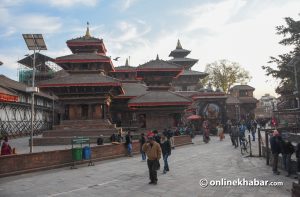Over a month ago, Roshan Man Shakya, the chair of the Kathmandu Durbar Square Conservation Programme under the Kathmandu metropolitan city, visited the Kumari Ghar, the home of the living goddess of Kathmandu, in Basantapur. He found the exterior of the religiously-important building sticky.
“I came to know that a paint named Black Japan was being used so as to prevent termites. It has an asphaltic base and when exposed to the sun, it turns off sticky and unattractive,” he says, “I thought it would degrade the image of the Kumari Ghar. Hence, I directed them to stop the use of Black Japan, and instead use a black powder mixed with gum and water.”
While the Kumari Ghar was being painted, heritage activist Alok Sidhhi Tuladhar was walking by the heritage site and saw the paint being used. He clicked a picture and did a quick investigation about what had happened. He found black oxide was to be used on the metal (bases), and it would be very damaging for the woodworks in the Kumari Ghar. Tuladhar also voiced disappointment with the “system that appoints people without knowledge and experience of heritage conservation.”

Soon, many social media users followed him, sparking a new debate about heritage conservation in Kathmandu.
Is Black Japan bad?
Shakya says his decision to stop the use of Black Japan was the result of his concern about the decorations and intricate architecture of the structure being destroyed by the previous techniques. He says it was his sincere bid to correct the mistake.
Shakya, who assumed office nine months ago, admits he is not an expert on chemicals or woodwork but says he was convinced that Black Japan was not appropriate to use in the wood as it would make the wooden surfaces sticky.
But, the owner of the National Handicrafts, a local wooden handicraft shop, Rajesh Maharjan says Black Japan is not problematic as claimed by Shakya. Instead, he says, “it is considered good for durability and saving the wood from termites and other bugs.”
Shakya says because he lacked expertise, as well as access to experts, he went to a local paint shop and asked the shopkeeper for advice before deciding to use what the shopkeeper called ‘black oxide’ instead of Black Japan.
Who decides repainting?
An official in the Department of Archaeology says there is a set procedure for renovation and reconstruction in a heritage site. It applies to all individuals and organisations. However, the source confirms, there has been no request from the Kathmandu Durbar Square Conservation Programme regarding the matter.
Another stakeholder of heritage conservation in Kathmandu, UNESCO, echoes the department’s view. Alina Tamrakar, Consultant-Architect for UNESCO in Kathmandu, says the department has a unit called the Central Conservation Lab for Cultural Heritage for consultation regarding issues of heritage conservation.
Further, Kathmandu Durbar Square is one of the seven areas listed as the World Heritage sites. Every country that is a signatory to the UNESCO World Heritage Convention has to follow and abide by its guidelines.

According to Nipuna Shrestha, the Head of Cultural Unit at UNESCO in Kathmandu, the UN agency is open to consultation and provide resources; physical, monetary, or intellectual. The agency is already involved in the preservation of the World Heritage sites, any additional assistance required can be sought following the due procedures, she says.
Here, Shakya’s claims that he did not have the resources or access to the experts fall short.
Shakya also claims if anyone had let him know what he was doing was wrong, he would have stopped it. Also, he claims he has not been questioned, neither suggested by any activist or commentators regarding ‘the right way’ even after the repainting.
But, an official in the Department of Archaeology says it had urged Shakya to stop the painting as soon as it knew about the issue. In response, his office said the painting was stopped. “We thought he had heeded to the request. But, later, we got to know that the office had continued with its plans.”
Maya Devi Aryal, Museum Officer at Hanuman Dhoka Durbar Herchah Adda under the department, says her office has asked Shakya to submit a written clarification too, which he is yet to respond to.
“We first asked them verbally regarding the (re)painting, to which they replied that the materials used were not harmful chemicals. Around two weeks ago, we again wrote an official letter to the office seeking written clarification.”
What to use then?
Meanwhile, Shakya also says there is no protocol or guidelines regarding what to use and what not to use. “The department also bans the use of enamel on wood so we cannot use it. My predecessors have applied harmful chemicals used to layer the zinc roofs, and red oxides on the doors, but there had not been any criticism. But, my decision invited the backlash.”
Aryal informs her office uses and recommends the use of linseed oil over the wooden material to more naturally preserve the heritage. Adding on this, she says, “Protocols and directives at both the offices (Hanuman Dhoka Durbar Herchah Adda and Kathmandu Durbar Square Conservation Programme) are not that different, so it is not possible that the office did not know about the alternatives to the chemical.”
These two offices are responsible to preserve the heritage in the area. “But, miscommunication was clearly seen as the two offices are just two-minutes away from each other. If the office had reached out on time, timely arrangement and proper conservation were possible,” Aryal asserts.
UNESCO’s Tamrakar also adds, “For the preservation of wood at recently reconstructed Radha Krishna temple in Teku, we used linseed oil as a termite-resistant element. It is also a natural way to conserve wooden surfaces. We use a coat of Black Japan at contact points of the brick wall and the doors or windows.”
Tej Ratna Tamrakar, a former director of Hanuman Dhoka Palace and Museum, recalls, “Kumari Ghar was white-washed before. It was in 1996 when I realised the building had a better, more traditional outlook. Then, we scraped off the white plaster to flaunt the brick exterior. I remember using sesame oil mixed with diluted turpentine oil and applying over the wooden doors and windows to preserve it.”

Was repainting necessary?
Contrary to the annual affair to make the Kumari Ghar attractive, many agree that colouring every year is not necessary.
UNESCO’s Tamrakar is also worried about the yearly use of enamel on the stone idol of Kaal Bhairav at Hanumandhoka established in the 7th century or older.
Retired officer Tej Ratna Tamrakar also says colouring every year only adds layers to the original. “The wood, the stone and the bricks all need some space to breathe. Using enamel or other chemicals might prevent the termites or external factors from destroying them to an extent, but what we don’t see is the damage we might be doing from inside. In my knowledge, the oil and the mixture with regular cleaning would be enough to preserve the natural look of the woods.”
So, what’s remedy now?
Now that the repainting is already there, what can be done? It is not easy to scrape off the layers of paints without destroying the originality of the architecture.
UNESCO Consultant Tamrakar says, “We need to understand the woods used in the heritage sites are not the same as those in our houses.” She says there are more serious concerns than the outer appearance of a building.
“Now, we have to assess the intensity of the damage and carefully scrape it off. It is a tedious job, yes. But this is important. By restoring the heritage, we are not just saving the tangible heritage asset, but with that, also discontinuing the harmful way of preserving heritage sites,” she elaborates, “We need to make conscious decisions to opt for a more natural, traditional way of conservation to protect our intangible heritage of century-old architecture and knowledge.”
Roshan Man Shakya, on his part, assures he is ready to follow guidelines if he finds any.


























